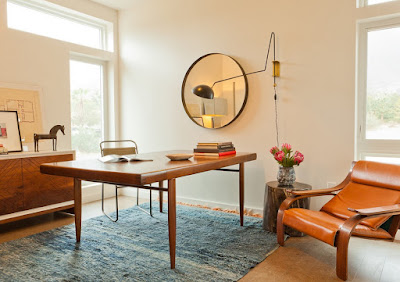Designing a home office that you actually want to work in can be a tough task. "It's about getting all the right components in all the right places (with a touch of personal flair) to create a room that will help you feel calm, confident, and happy while working," says Laura Drucker, of the Daily Muse in her article Design a Home Office You'll Actually Work In. You have to find that good medium between making the space user friendly and efficient, and ensuring that it reflects your personality. When you feel like that space is your own, you will enjoy being in it. "When designed well, your home office becomes a 'silent partner,' supporting your efforts and increasing your effectiveness," says Terri Lonier, who runs a consulting firm called Working Solo, which specializes in the small business and home-based business markets.
Types of offices:
WorkThere are three main types of offices. First, there is the work office. Many people work from home. In fact, more than 33 million workers in the U.S. -- including employees, contractors, and small business owners -- spend some time working from home, according to World at Work. Some operate full time out of their home office, and others bring work home, operating from both an actual office and their home office.
Another type, is the studio office. This office is for crafty hobbies, like painting, scrap booking, sewing, etc, that might require a large work area and ample storage.
Leisure
Finally, you can have an office for leisure, a place to relax, play on your computer, open your mail, etc. Maybe you aren't actually operating your job from home, but you do like to have that designated peaceful area where you sit and concentrate on a task.
How do you design your home office?
There are are few essential things to consider:
Privacy
Deciding where to set up your home office is first. Many times an extra bedroom allots for the perfect space. Or maybe your home was built with a room designated for an office. But sometimes, living in an inner city means a smaller apartment and your office might have to be a shared space. Either way, you want your office to be in a place where you have enough privacy to avoid distractions. The beauty of working at home is that you don't have to be totally disconnected from your home life, but you still need to have that good balance so that you are able to "tune-it-out" when you really need to. "It doesn't necessarily need to be separated by walls, but it should be an area where work gets done and an area that is not impinged upon by what you do in the rest of that space," says Neal Zimmerman, an architect and designer who specializes in home office design.
Layout and Organization/Storage
You want to carefully think through your storage requirements and make sure you have a place for everything. Solutions are simple... pencil cups, trays, memo and business card holders, even pretty bowls for the little stuff; and shelves and cabinets for the larger stuff. The items you need to access the most should be within easy reach, and others can be stored in a more remote place. The layout is very important. You want the flow of the space to work best for you. " Think of the space as a cockpit that enables you to move from task to task with a minimal amount of effort," says Lonier. The primary space should be devoted to the tasks you do the most.
Some desk layout options include:
- U-shape
- L-shape
- on a diagonal
- desk in center with storage (built-ins) on back wall
- extra chairs or sofa for visitors
- if the space allows, 2 work stations (his and her or maybe one for the computer and another for other work)
Equipment
Decide what equipment you will need for your type of work; printer, phone, computer, etc. You also want to work these fixtures into your layout and organization. Many times they are the items you need in your primary space.
Lighting
Good lighting is essential for your work space. Ideally you want as much daylight as possible. Along with natural light you want a good combination of general and task lighting. General lighting includes your rooms main source of light, usually recessed or flush mount lights. Task lighting includes lamps or maybe a wall sconce with an arm. These are directed in an area for a specific task.
Ergonomics
"Items you choose should be ergonomically designed to promote your health and well-being while using them," says Jo Heinz, a professional designer and auther of How to Design the Ideal Office. This includes, chairs, mouse instruments, foot rests, etc.
Your Personality
DON'T FORGET to make the space reflect your personality. Remember, making it a space fun and characteristic of yourself is the best way to make it a space you want to work in.
NOW CHECK OUT THESE SUPER COOL OFFICES!
In the office below is a Windsor Chair!! Check out our History Lesson this month and read up on this fabulous chair that truly looks great in almost any application!
Helloooooo Gunlocke Chair! In the office below you'll notice a Gunlocke front and center. One of our designers, Stevi, is currently refinishing that exact chair that she found at a thrift store for five dollars! We love the bold use of blue velvet on this chair! Should Stevi cover hers in blue velvet (David Lynch, anyone)? Stay tuned for our next history lesson on the Gunlocke Chair.
Source
Source



























No comments:
Post a Comment